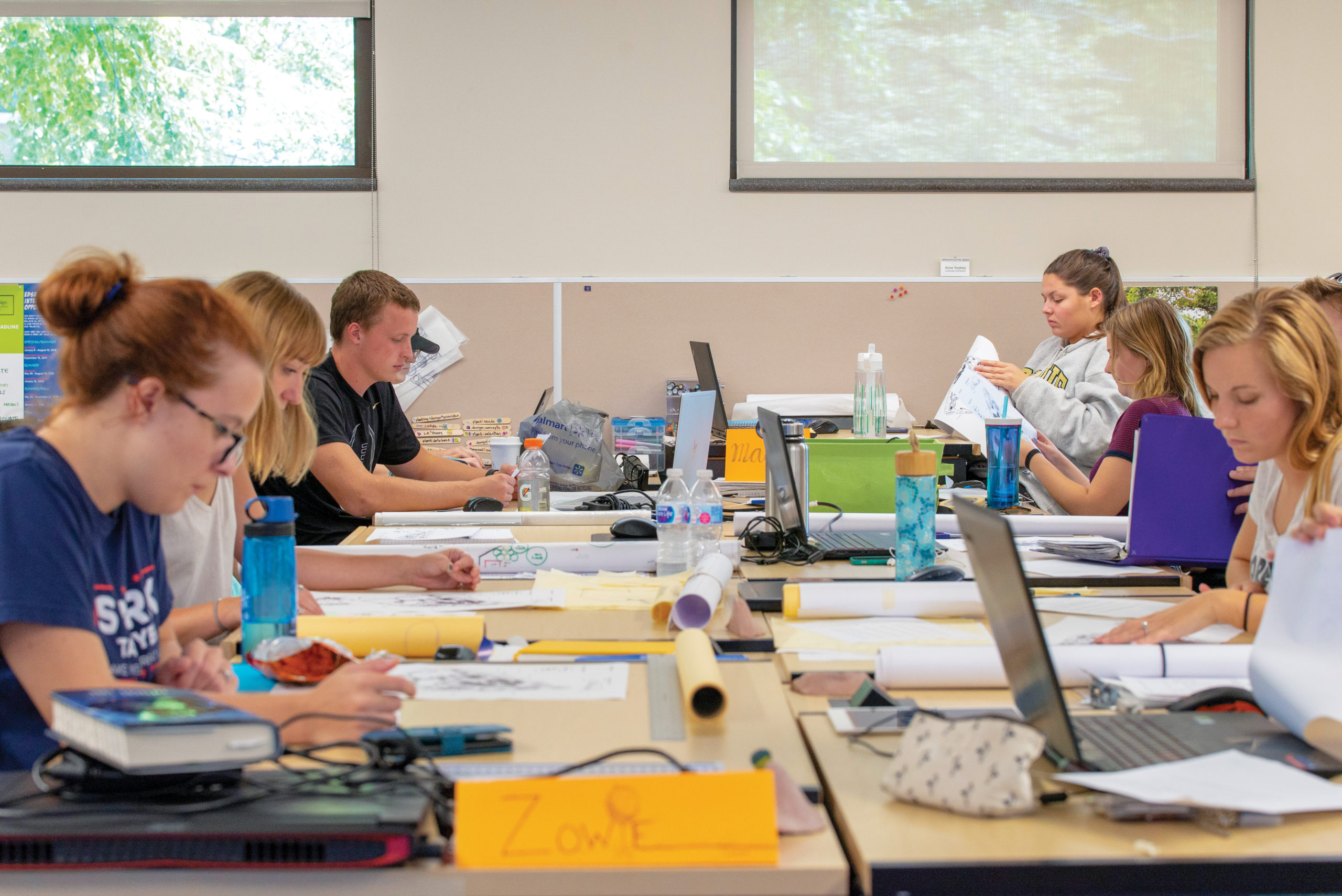

Designing a Healing Space
When a community experiences tragedy and trauma, it’s transformed. It’s often transformed again as people join together to grieve and find a way to move forward. One Indiana town all too familiar with heartbreak is beginning this process, with students in Purdue’s landscape architecture program by their side.
In Delphi, Indiana, family members, friends and the entire community were devastated by the murder of Abigail “Abby” Williams and Liberty “Libby” German in February 2017. The girls never returned from a walk, and their bodies were soon discovered near the Monon High Bridge Trail. Nearly three years later, their killer remains at large.
Delphi needs to be known for something else, says Eric Erskin, like it was before the murders. As the grandfather of Abby Williams, he and his wife Diane find themselves in a position to lead this evolution, ensuring healing and closure don’t hinge on resolution of the criminal case.
The space at the heart of this effort is a park that pays honest and intentional tribute to the lives Liberty and Abby led. When people from around the world reached out with condolences and donations, the Erskins and Libby’s grandparents, Mike and Becky Patty, felt a pressing need to establish a memorial. Mike initiated the idea of a softball field and park complex, and set up a foundation.
 The project has been a collaboration between the families ever since. “We want people to be able to come to the park and say, ‘This is a park we helped build,’” Diane Erskin says.
The project has been a collaboration between the families ever since. “We want people to be able to come to the park and say, ‘This is a park we helped build,’” Diane Erskin says.
That idea will hold especially true for the 18 members of Purdue University’s landscape architecture junior studio class, instructed by Aaron Thompson, assistant professor of landscape architecture, as well as Professor of Horticulture Cale Bigelow. A College of Agriculture alumna introduced the Erskins to Bigelow, a turf specialist with expertise in sports turf construction and management. He has headed an effort within the college to harness resources, arrange introductions and tap alumni networks, like those who manage stadium fields, to support the park’s development, rallying turf industry experts and suggesting grant opportunities. “The nature of what I do is at the intersection of urban and rural communities, which introduces you to a lot of different areas and a lot of different people,” Bigelow says. “For this reason, I’ve been able to facilitate some introductions and get the grandparents talking to the right people.”
For the Pattys and Erskins, tapping into that expertise is key to what they’re trying to achieve. “We’re not park designers or architects or web designers,” Eric Erskin says. “We’re just a grandma and grandpa. And we only want to build this park once.”
Landscape as tribute
In fall 2018, Bigelow brought his colleague Thompson into the fold. Thompson decided it was a perfect opportunity for his junior studio class to put their newly acquired design skills to use and charged each of them with crafting a design for the Abby & Libby Memorial Park. For Thompson, the project highlighted an aspect of landscape architecture beyond the drafting board.
“At the core of landscape architecture, we spend as much time creating community as we do creating places. In this class, we spend a lot of time focused on how to read a site from an ecological standpoint, but we also try to understand it from the social landscape. We ask: ‘What are the needs of the community that will come together in that space?’ You can see how the Delphi project fits into that,” Thompson reflects.
When a community experiences tragedy and trauma, it’s transformed. It’s often transformed again as people join together to grieve and find a way to move forward. One Indiana town all too familiar with heartbreak is beginning this process, with students in Purdue’s landscape architecture program by their side.
In Delphi, Indiana, family members, friends and the entire community were devastated by the murder of Abigail “Abby” Williams and Liberty “Libby” German in February 2017. The girls never returned from a walk, and their bodies were soon discovered near the Monon High Bridge Trail. Nearly three years later, their killer remains at large.
Delphi needs to be known for something else, says Eric Erskin, like it was before the murders. As the grandfather of Abby Williams, he and his wife Diane find themselves in a position to lead this evolution, ensuring healing and closure don’t hinge on resolution of the criminal case.
The space at the heart of this effort is a park that pays honest and intentional tribute to the lives Liberty and Abby led. When people from around the world reached out with condolences and donations, the Erskins and Libby’s grandparents, Mike and Becky Patty, felt a pressing need to establish a memorial. Mike initiated the idea of a softball field and park complex, and set up a foundation.
The project has been a collaboration between the families ever since. “We want people to be able to come to the park and say, ‘This is a park we helped build,’” Diane Erskin says.
That idea will hold especially true for the 18 members of Purdue University’s landscape architecture junior studio class, instructed by Aaron Thompson, assistant professor of landscape architecture, as well as Professor of Horticulture Cale Bigelow. A College of Agriculture alumna introduced the Erskins to Bigelow, a turf specialist with expertise in sports turf construction and management. He has headed an effort within the college to harness resources, arrange introductions and tap alumni networks, like those who manage stadium fields, to support the park’s development, rallying turf industry experts and suggesting grant opportunities. “The nature of what I do is at the intersection of urban and rural communities, which introduces you to a lot of different areas and a lot of different people,” Bigelow says. “For this reason, I’ve been able to facilitate some introductions and get the grandparents talking to the right people.”
For the Pattys and Erskins, tapping into that expertise is key to what they’re trying to achieve. “We’re not park designers or architects or web designers,” Eric Erskin says. “We’re just a grandma and grandpa. And we only want to build this park once.”
Landscape as tribute
In fall 2018, Bigelow brought his colleague Thompson into the fold. Thompson decided it was a perfect opportunity for his junior studio class to put their newly acquired design skills to use and charged each of them with crafting a design for the Abby & Libby Memorial Park. For Thompson, the project highlighted an aspect of landscape architecture beyond the drafting board.
“At the core of landscape architecture, we spend as much time creating community as we do creating places. In this class, we spend a lot of time focused on how to read a site from an ecological standpoint, but we also try to understand it from the social landscape. We ask: ‘What are the needs of the community that will come together in that space?’ You can see how the Delphi project fits into that,” Thompson reflects.
This marked the first time students would draft a comprehensive space instead of certain facets, and also their first opportunity to incorporate the needs and visions of a client and the constraints that can impose.
“Because of the way the property is laid out, we can only have the driveway in one place and, consequently, the ballfields can only be in one spot,” Eric Erskin explains. “It was fun when I started meeting with the students and at first they were putting things all over the place. You could actually watch them realize that there only is one place they could put the ballfields, only one place they could put the driveway. That’s a real-life aha moment for them.”
In addition to ballfields, there are several other must-haves for the families, including an amphitheater, play areas, walking trails, and meeting and event spaces for local clubs. These features reflect Abby and Libby’s different passions, from their interest in music and softball to their love of nature. On top of fitting all this into the rectangular plot of land, the students’ imaginations were checked by train tracks flanking one side of the property and roadways on two other borders.
Ellen Joseph, a junior in landscape architecture, says working on the project allowed her to flex her creative muscles and cement aspects of her training. In her plan, Joseph ensured must-haves were given spots of easy accessibility and prominence but added several other features she hopes will encourage community use. She incorporated a multipurpose space that can host events from farmers markets to art fairs, a walking trail snaking through a wooded area into prairie land and a spot for a memorial statue or plaque.
“I think this park has the potential to help the community heal,” Joseph says. “There are so many people involved with this project that it’s already doing that — it’s already drawing the community closer together.”
Miles Romans, who also took the studio class, says what truly made the project challenging was working within the invisible space of a tragedy, especially one that touched the community of Delphi and the state of Indiana so deeply. It was a fresh experience, he says, but a wake-up call that landscape architects are not just working inside physical and financial boundaries but also always at the intersections of a community’s history, relationships and aspirations.
“I wanted my park to be inclusive, not just for kids, but a place that would unite the community and a destination for people from all over the state,” Romans adds. “For that reason, I didn’t create my design with a primary feature or singular focus. The memory of the girls molds the heart and spirit of the park, but physically, the park’s many connections and nodes represent the girls’ relationships with family, friends and fun.”
Final versions of each design were given to the park foundation. Thompson says the students know that no one design will be used; more likely the foundation will use the plans as inspiration to pick and choose elements they want in the new space. While students had time to work on their designs independently, the entire project was an exercise in collaboration and sharing, as they talked through different concepts and processed the idea of themselves as social engineers as well as architects.
This marked the first time students would draft a comprehensive space instead of certain facets, and also their first opportunity to incorporate the needs and visions of a client and the constraints that can impose.
“Because of the way the property is laid out, we can only have the driveway in one place and, consequently, the ballfields can only be in one spot,” Eric Erskin explains. “It was fun when I started meeting with the students and at first they were putting things all over the place. You could actually watch them realize that there only is one place they could put the ballfields, only one place they could put the driveway. That’s a real-life aha moment for them.”
In addition to ballfields, there are several other must-haves for the families, including an amphitheater, play areas, walking trails, and meeting and event spaces for local clubs. These features reflect Abby and Libby’s different passions, from their interest in music and softball to their love of nature. On top of fitting all this into the rectangular plot of land, the students’ imaginations were checked by train tracks flanking one side of the property and roadways on two other borders.
Ellen Joseph, a junior in landscape architecture, says working on the project allowed her to flex her creative muscles and cement aspects of her training. In her plan, Joseph ensured must-haves were given spots of easy accessibility and prominence but added several other features she hopes will encourage community use. She incorporated a multipurpose space that can host events from farmers markets to art fairs, a walking trail snaking through a wooded area into prairie land and a spot for a memorial statue or plaque.
“I think this park has the potential to help the community heal,” Joseph says. “There are so many people involved with this project that it’s already doing that — it’s already drawing the community closer together.”
Miles Romans, who also took the studio class, says what truly made the project challenging was working within the invisible space of a tragedy, especially one that touched the community of Delphi and the state of Indiana so deeply. It was a fresh experience, he says, but a wake-up call that landscape architects are not just working inside physical and financial boundaries but also always at the intersections of a community’s history, relationships and aspirations.
“I wanted my park to be inclusive, not just for kids, but a place that would unite the community and a destination for people from all over the state,” Romans adds. “For that reason, I didn’t create my design with a primary feature or singular focus. The memory of the girls molds the heart and spirit of the park, but physically, the park’s many connections and nodes represent the girls’ relationships with family, friends and fun.”
Final versions of each design were given to the park foundation. Thompson says the students know that no one design will be used; more likely the foundation will use the plans as inspiration to pick and choose elements they want in the new space. While students had time to work on their designs independently, the entire project was an exercise in collaboration and sharing, as they talked through different concepts and processed the idea of themselves as social engineers as well as architects.
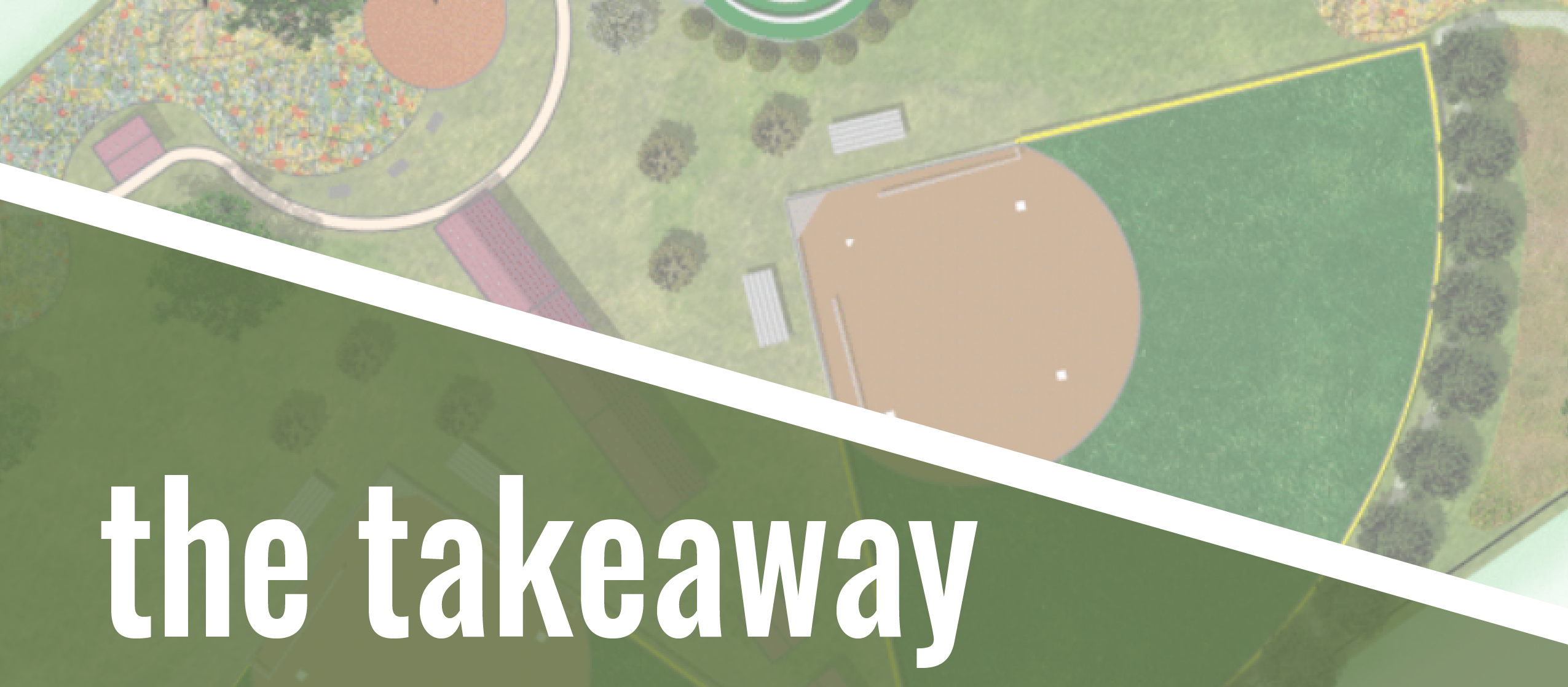
- Landscape architecture students in Aaron Thompson’s junior studio class created designs for Abby & Libby Memorial Park, a tribute to Abby Williams and Libby German, two girls from Delphi, Indiana, who were murdered near the Monon High Bridge Trail. Their families are spearheading efforts to develop the park.
- Students in the program are encouraged to think about how their designs create community, which is especially relevant for this project. Purdue’s landscape architecture major is approximately 60 years old, and is unique because it’s separate from a school of architecture. Classes are small, and students are in close contact with their classmates and faculty.
- Abby & Libby Memorial Park will include softball fields, an amphitheater, play areas and walking trails. The site, near downtown Delphi, is bordered on one side by train tracks and on two others by roadways, making it challenging for designers.
- Final versions of the designs were given to the park foundation. While no one design will be used, they serve as inspiration for features the families might like to include as fundraising and the park’s development continue.
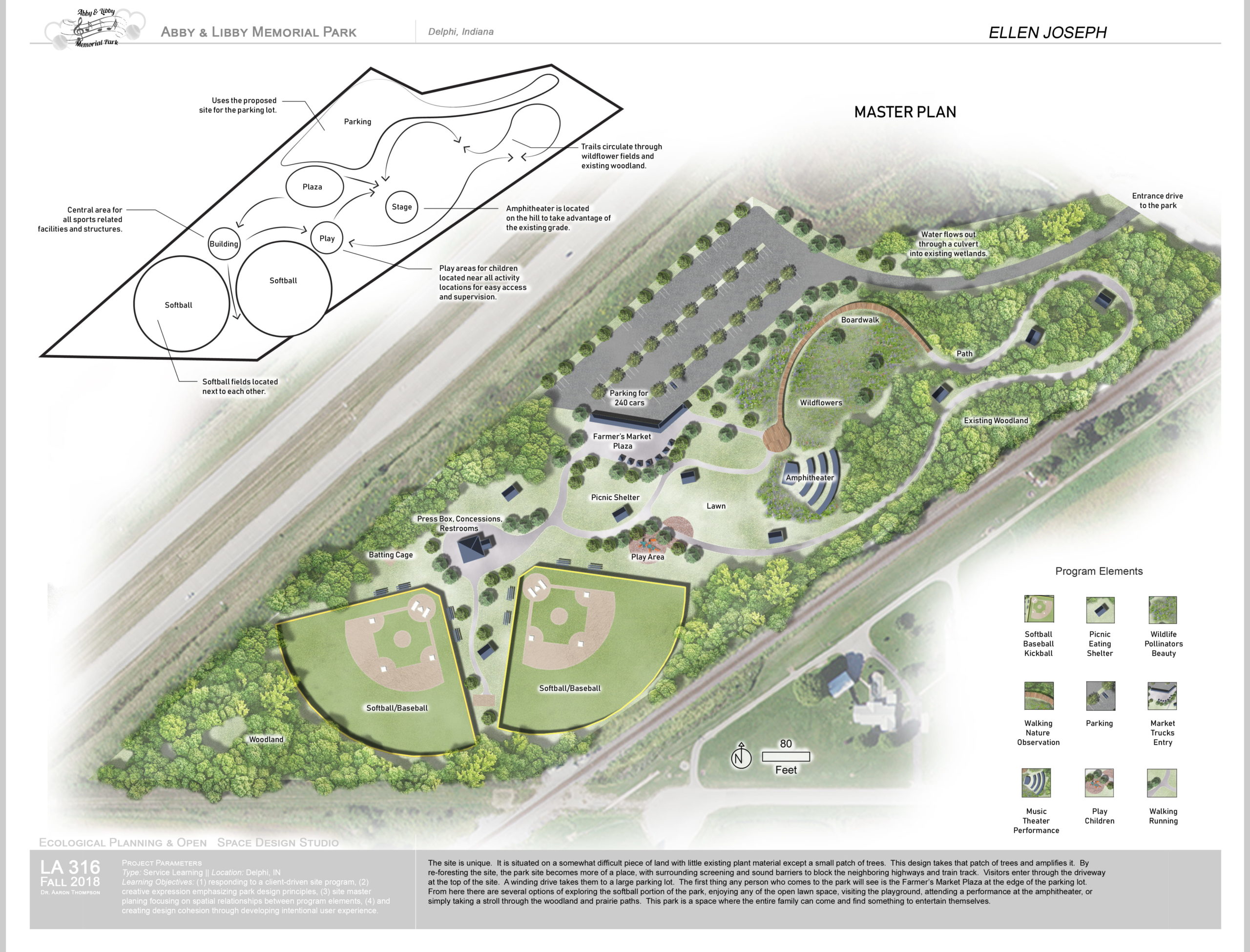

- Landscape architecture students in Aaron Thompson’s junior studio class created designs for Abby & Libby Memorial Park, a tribute to Abby Williams and Libby German, two girls from Delphi, Indiana, who were murdered near the Monon High Bridge Trail. Their families are spearheading efforts to develop the park.
- Students in the program are encouraged to think about how their designs create community, which is especially relevant for this project. Purdue’s landscape architecture major is approximately 60 years old, and is unique because it’s separate from a school of architecture. Classes are small, and students are in close contact with their classmates and faculty.
- Abby & Libby Memorial Park will include softball fields, an amphitheater, play areas and walking trails. The site, near downtown Delphi, is bordered on one side by train tracks and on two others by roadways, making it challenging for designers.
- Final versions of the designs were given to the park foundation. While no one design will be used, they serve as inspiration for features the families might like to include as fundraising and the park’s development continue.

This marked the first time students would draft a comprehensive space instead of certain facets, and also their first opportunity to incorporate the needs and visions of a client and the constraints that can impose.
“Because of the way the property is laid out, we can only have the driveway in one place and, consequently, the ballfields can only be in one spot,” Eric Erskin explains. “It was fun when I started meeting with the students and at first they were putting things all over the place. You could actually watch them realize that there only is one place they could put the ballfields, only one place they could put the driveway. That’s a real-life aha moment for them.”
In addition to ballfields, there are several other must-haves for the families, including an amphitheater, play areas, walking trails, and meeting and event spaces for local clubs. These features reflect Abby and Libby’s different passions, from their interest in music and softball to their love of nature. On top of fitting all this into the rectangular plot of land, the students’ imaginations were checked by train tracks flanking one side of the property and roadways on two other borders.
Ellen Joseph, a junior in landscape architecture, says working on the project allowed her to flex her creative muscles and cement aspects of her training. In her plan, Joseph ensured must-haves were given spots of easy accessibility and prominence but added several other features she hopes will encourage community use. She incorporated a multipurpose space that can host events from farmers markets to art fairs, a walking trail snaking through a wooded area into prairie land and a spot for a memorial statue or plaque.
“I think this park has the potential to help the community heal,” Joseph says. “There are so many people involved with this project that it’s already doing that — it’s already drawing the community closer together.”
Miles Romans, who also took the studio class, says what truly made the project challenging was working within the invisible space of a tragedy, especially one that touched the community of Delphi and the state of Indiana so deeply. It was a fresh experience, he says, but a wake-up call that landscape architects are not just working inside physical and financial boundaries but also always at the intersections of a community’s history, relationships and aspirations.
“I wanted my park to be inclusive, not just for kids, but a place that would unite the community and a destination for people from all over the state,” Romans adds. “For that reason, I didn’t create my design with a primary feature or singular focus. The memory of the girls molds the heart and spirit of the park, but physically, the park’s many connections and nodes represent the girls’ relationships with family, friends and fun.”
Final versions of each design were given to the park foundation. Thompson says the students know that no one design will be used; more likely the foundation will use the plans as inspiration to pick and choose elements they want in the new space. While students had time to work on their designs independently, the entire project was an exercise in collaboration and sharing, as they talked through different concepts and processed the idea of themselves as social engineers as well as architects.
"I think this park has the potential to help the community heal."
— Ellen Joseph, landscape architecture student
Abby’s grandfather Eric Erskin, Abby’s mother Anna Williams, Libby’s grandparents Becky and Mike Patty, and Abby’s grandmother Diane Erskin, gather for a work day at Abby & Libby Memorial Park.
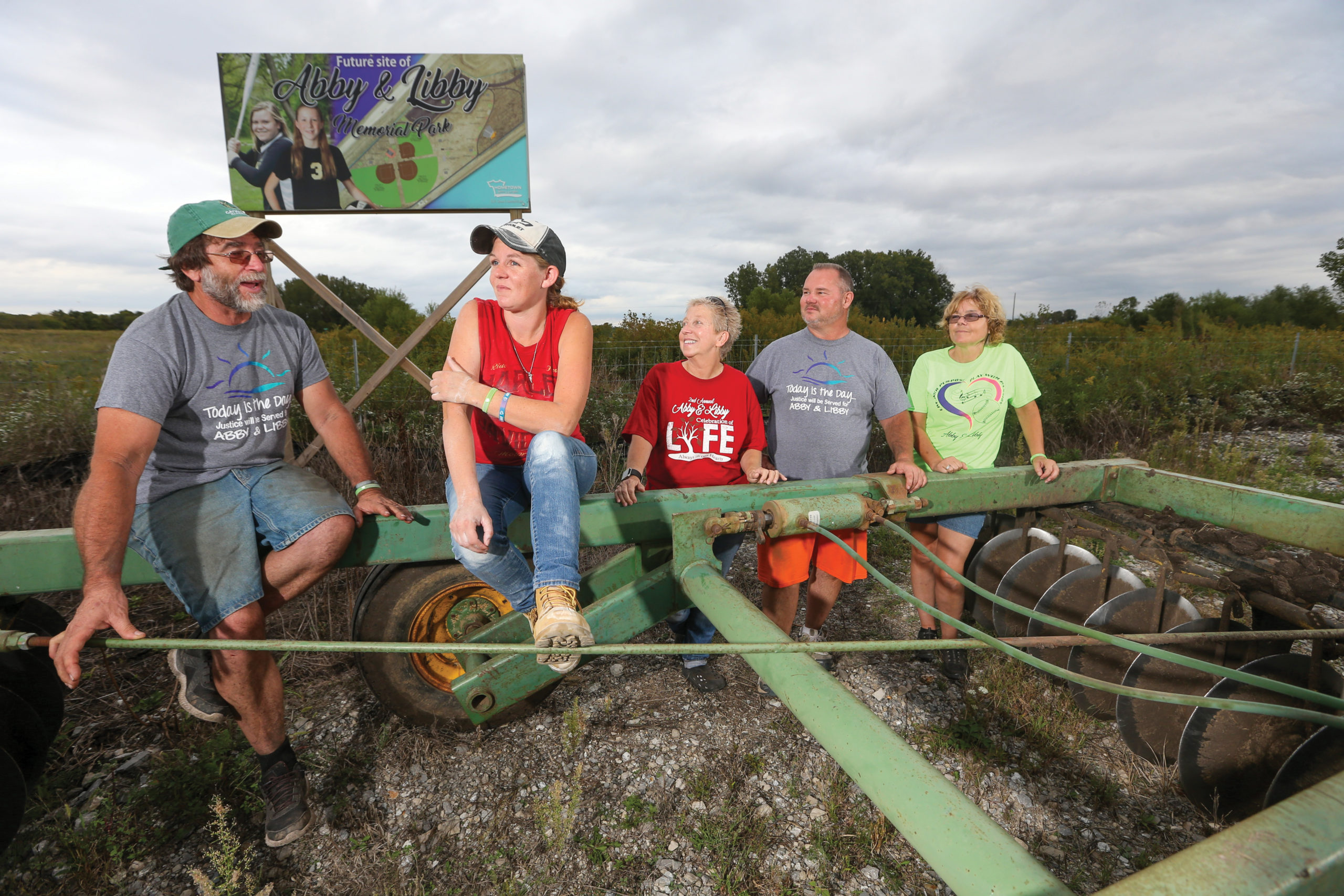
"I think this park has the potential to help the community heal."
— Ellen Joseph, landscape architecture student
Abby’s grandfather Eric Erskin, Abby’s mother Anna Williams, Libby’s grandparents Becky and Mike Patty, and Abby’s grandmother Diane Erskin, gather for a work day at Abby & Libby Memorial Park.
Designing a community
Community building is the core of Purdue’s landscape architecture program. Each class is between 20 and 30 people, and students move through the structured curriculum as a unit, spending most of their class time and much of their free time with landscape architecture peers and faculty. It’s a unique feature of the major at Purdue says Thompson, who received his bachelor’s degree from the same program in 2002.
“The landscape architecture program has been around for about 60 years at Purdue,” Thompson continues. “What makes it different from other programs around the country is that it’s separate from a school of architecture. For students, that means they have very personal relationships with faculty and with each other. We are a small community with our own classroom spaces for teaching and studio spaces for creating.”
Joseph says the intimate nature of the major as well as the blending of art and function drew her away from civil engineering. “Your peers become your friends, and your professors are your mentors as well as your instructors,” Joseph says. “We all know each other really well. For example, even after the studio class, we are all on this group text, and any time news about Abby and Libby breaks, we’re all on the thread, sharing what we know. I think we all feel a lot closer to the incident and, in some small way, feel we were able to give something to the girls.”
Purpose and passion
The Erskins say the park would not have progressed as far without the help of students and faculty in the College of Agriculture. “We are big proponents of education. The girls were just getting ready to sign up for freshman classes and it was an exciting time for them,” Diane Erskin reminisces. “One message we are trying to promote is that young people should find their passion, whether that’s in college or as an apprentice somewhere, and pursue it. And the college students who created these designs were doing just that.” She hopes educational groups like Indiana 4-H and FFA will use the park.
The families’ connections to Purdue are numerous. Kelsi German, Libby’s sister, is majoring in psychology with a minor in forensic science. She transferred to Purdue in fall 2019 to pursue a course of study that honors and advocates for her sister.
“My studies have really helped me better understand so much of what happened after the girls were found,” she says. “At the time it was easy to feel frustrated with investigators and the police, but now I better understand why they had to do certain things. I also feel that I’ve been better able to advocate for the girls at Purdue and connect with people who are as passionate about finding the man who did this as I am.”
And the Purdue Research Foundation, which now owns the land from the former intramural fields at State Street and Airport Road, donated 10 banks of lights and their support poles, which Duke Energy dismantled and transported to the park free of charge.
Thompson hopes the project will help the tight-knit community heal. “I think ‘shattered’ is the right term for what happened to Delphi after losing the girls,” Thompson says. “Delphi is a community that has always really valued its parks, and for what happened to the girls to happen within the parks system the community is so dedicated to was a shock. I think the only thing that made sense for them to do was to begin building a park.”
Banner: Students in Professor Aaron Thompson’s Landscape Architecture 316 class work on their designs for Abby & Libby Memorial Park. Photo by David Barbarash.
Right: Mike Patty, grandfather of Liberty German, discs the ground around the softball fields with a tractor loaned by Brian Jones of Delphi.
The Takeaway: Schematic from Ellen Joseph’s park design.
Left: The site of Abby & Libby Memorial Park gives hope to the Delphi community.
Designing a community
Community building is the core of Purdue’s landscape architecture program. Each class is between 20 and 30 people, and students move through the structured curriculum as a unit, spending most of their class time and much of their free time with landscape architecture peers and faculty. It’s a unique feature of the major at Purdue says Thompson, who received his bachelor’s degree from the same program in 2002.
“The landscape architecture program has been around for about 60 years at Purdue,” Thompson continues. “What makes it different from other programs around the country is that it’s separate from a school of architecture. For students, that means they have very personal relationships with faculty and with each other. We are a small community with our own classroom spaces for teaching and studio spaces for creating.”
Joseph says the intimate nature of the major as well as the blending of art and function drew her away from civil engineering. “Your peers become your friends, and your professors are your mentors as well as your instructors,” Joseph says. “We all know each other really well. For example, even after the studio class, we are all on this group text, and any time news about Abby and Libby breaks, we’re all on the thread, sharing what we know. I think we all feel a lot closer to the incident and, in some small way, feel we were able to give something to the girls.”
Purpose and passion
The Erskins say the park would not have progressed as far without the help of students and faculty in the College of Agriculture. “We are big proponents of education. The girls were just getting ready to sign up for freshman classes and it was an exciting time for them,” Diane Erskin reminisces. “One message we are trying to promote is that young people should find their passion, whether that’s in college or as an apprentice somewhere, and pursue it. And the college students who created these designs were doing just that.” She hopes educational groups like Indiana 4-H and FFA will use the park.
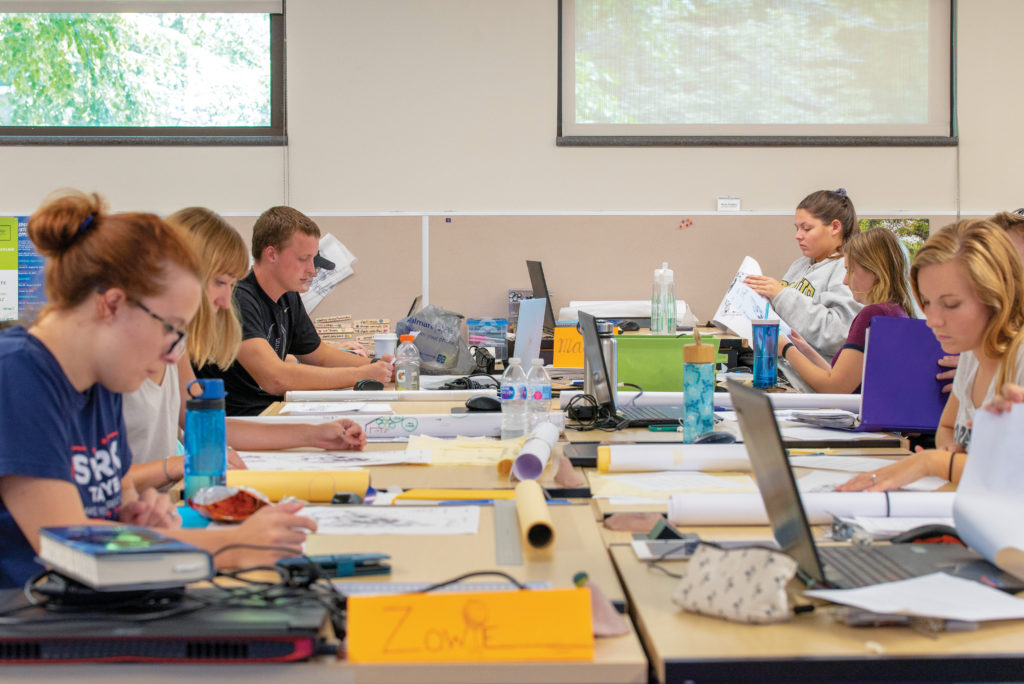 The families’ connections to Purdue are numerous. Kelsi German, Libby’s sister, is majoring in psychology with a minor in forensic science. She transferred to Purdue in fall 2019 to pursue a course of study that honors and advocates for her sister.
The families’ connections to Purdue are numerous. Kelsi German, Libby’s sister, is majoring in psychology with a minor in forensic science. She transferred to Purdue in fall 2019 to pursue a course of study that honors and advocates for her sister.
“My studies have really helped me better understand so much of what happened after the girls were found,” she says. “At the time it was easy to feel frustrated with investigators and the police, but now I better understand why they had to do certain things. I also feel that I’ve been better able to advocate for the girls at Purdue and connect with people who are as passionate about finding the man who did this as I am.”
And the Purdue Research Foundation, which now owns the land from the former intramural fields at State Street and Airport Road, donated 10 banks of lights and their support poles, which Duke Energy dismantled and transported to the park free of charge.
Thompson hopes the project will help the tight-knit community heal. “I think ‘shattered’ is the right term for what happened to Delphi after losing the girls,” Thompson says. “Delphi is a community that has always really valued its parks, and for what happened to the girls to happen within the parks system the community is so dedicated to was a shock. I think the only thing that made sense for them to do was to begin building a park.”
Banner: The site of Abby & Libby Memorial Park gives hope to the Delphi community.
2nd Image: Mike Patty, grandfather of Liberty German, discs the ground around the softball fields with a tractor loaned by Brian Jones of Delphi.
The Takeaway: Schematic from Ellen Joseph’s park design.
Above: Students in Professor Aaron Thompson’s Landscape Architecture 316 class work on their designs for Abby & Libby Memorial Park. Photo by David Barbarash
Purdue Agriculture, 615 Mitch Daniels Blvd, West Lafayette, IN 47907-2053 USA, (765) 494-8392
© 2025 The Trustees of Purdue University | An Equal Access/Equal Opportunity University | USDA non-discrimination statement | Integrity Statement | Copyright Complaints | Maintained by Agricultural Communications
Trouble with this page? Disability-related accessibility issue? Please contact us at ag-web-team@purdue.edu so we can help.

